The extra cabinet stiffness the reflectors impart may slightly increase upper response at high level, but the cabinet volume is reduced by the reflectors, reducing LF output by a tiny bit.
The horn path length remains the same, so the LF cutoff does not change.
I had mouth braces that "fixed" a 200Hz resonance, but they messed with the way the mouth worked and SPL dropped... Bye bye braces
Hi weltersys!
"The extra cabinet stiffness the reflectors impart may slightly increase upper response at high level, but the cabinet volume is reduced by the reflectors, reducing LF output by a tiny bit.
The horn path length remains the same, so the LF cutoff does not change."
May I share my experience with six jbell ss15 cabinets I build:stifness of reflectors show me (to my ears and eyes) clearly improvement at upper response (definition of bass guitar notes) as well as mouth bracing (now it doens't flexes at hand touch), plus cone correction, with dishes in some and long slats in front of the cone in others, excursion becomes more controled, and also notoriously goes lower (low cut LR 38Hz) => less power compression. Now for me it's a pleasure hear lows thru it.
Re Pabescos low cut TH18 with 18sound 2400 that we tested beside others innit, with music till around clean 1200W couldn't go bellow 38Hz low cut to preserve the driver as cone was out of control (without cone correction); would say be at clean 1000W maximum.
Regards,
"The extra cabinet stiffness the reflectors impart may slightly increase upper response at high level, but the cabinet volume is reduced by the reflectors, reducing LF output by a tiny bit.
The horn path length remains the same, so the LF cutoff does not change."
May I share my experience with six jbell ss15 cabinets I build:stifness of reflectors show me (to my ears and eyes) clearly improvement at upper response (definition of bass guitar notes) as well as mouth bracing (now it doens't flexes at hand touch), plus cone correction, with dishes in some and long slats in front of the cone in others, excursion becomes more controled, and also notoriously goes lower (low cut LR 38Hz) => less power compression. Now for me it's a pleasure hear lows thru it.
Re Pabescos low cut TH18 with 18sound 2400 that we tested beside others innit, with music till around clean 1200W couldn't go bellow 38Hz low cut to preserve the driver as cone was out of control (without cone correction); would say be at clean 1000W maximum.
Regards,
Last edited:
Another build
Hi Xoc1 and all of you who have contributed to this design
Another build of these cabs only just done in Denmark.
I am doing 2 pairs of the version 1 with cone correction from CRESCENDO.
I am using b&c18sw100-8.
Unforfortunately in the first build I wasn't paying attention and put the baffle wrong. I am using Baltic plywood so a rather expensive mistake
I think I managed to keep the S1 and S2 fairly within the measurments, but I would really like to know if someone could help me find out how far off the performance will be approximately since the horn path is not exactly as per the original design. It doesn't have to be exact just a hint on whether I should trash it or if you think the performance is going to be ok.
I don't know if you can make out the mistake from the rather bad pictures:
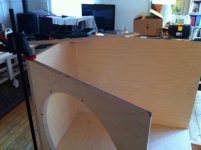
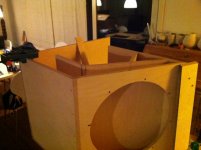
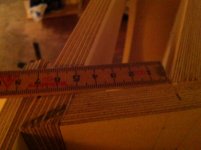
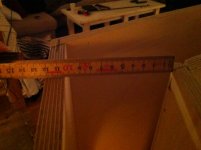
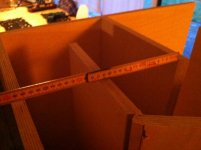
And this last one only gives an impression of the differences btw. the first and second build, the second build being the blue.
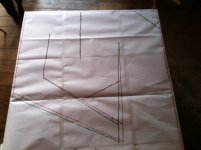
I have more pictures of the builds if you like.
I have not yet done any serious testing, but first impression with this first build comparing with a 200 litre reflext cab with b&c18ps100 is that it goes noticeable louder and has more kick in the 80-120 hz region, but I am missing the low end <60HZ. I am hoping that it will change when the driver is broke in.
I will put a driver in my second build this weekend and check by ear if there is a big difference.
Thanks,
Andy
Hi Xoc1 and all of you who have contributed to this design
Another build of these cabs only just done in Denmark.
I am doing 2 pairs of the version 1 with cone correction from CRESCENDO.
I am using b&c18sw100-8.
Unforfortunately in the first build I wasn't paying attention and put the baffle wrong. I am using Baltic plywood so a rather expensive mistake
I think I managed to keep the S1 and S2 fairly within the measurments, but I would really like to know if someone could help me find out how far off the performance will be approximately since the horn path is not exactly as per the original design. It doesn't have to be exact just a hint on whether I should trash it or if you think the performance is going to be ok.
I don't know if you can make out the mistake from the rather bad pictures:





And this last one only gives an impression of the differences btw. the first and second build, the second build being the blue.

I have more pictures of the builds if you like.
I have not yet done any serious testing, but first impression with this first build comparing with a 200 litre reflext cab with b&c18ps100 is that it goes noticeable louder and has more kick in the 80-120 hz region, but I am missing the low end <60HZ. I am hoping that it will change when the driver is broke in.
I will put a driver in my second build this weekend and check by ear if there is a big difference.
Thanks,
Andy
Maybe it's a lack of distortion down low that you're hearing and misinterpting it?
About the missing low end? I take it back
Today I gave it a little more volume and lowered 60-100hz about 2-4db and it really started to shine. Amazing how it's now blowing my old ported sub away.
On another note, I am building second pair during next week and I was wondering if my old b&c18ps100 could work temporarily if I keep the volume down?
/Andy
Evening all from a newbie in the UK. I'm busying myself manufacturing a pair of braced TH18's loaded with PD1850 Mk2 drivers. My enquiry is advice on what cable to use from the rear Speakon connectors to the PD1850? Also, (although I expect this has already been discussed), where would I set the crossover frequency for best effect?
Regards
Regards
Evening all from a newbie in the UK. I'm busying myself manufacturing a pair of braced TH18's loaded with PD1850 Mk2 drivers. My enquiry is advice on what cable to use from the rear Speakon connectors to the PD1850? Also, (although I expect this has already been discussed), where would I set the crossover frequency for best effect?
Regards
I like the kick that these cabs are capable of and I have the amp headroom to allow for a higher crossover, so I depending on the setup and content it'll be anywhere from 90-110Hz.
What works for you and your setup may be different.
Thanks for the quick response Dan, I was expecting to crossover around somewhere around 80hz, but from what you've said, you've confirmed my thoughts that maybe there's a little more to be had from them headroom wise. I'm pleased they apparantly have a kick to them ... I'm looking forward to the day their finished!
Regards Charly
Regards Charly
Gents,
Is there a way to safeguard against destroying or wearing out the drivers(b&c18sw100) by to much excursion?
I read somewhere that the 'danger zone' wih this cab is about 50 HZ.
My amp is 650 wats/8ohm
I have put a 35HZ High pass 18/db on my DBX drive rack pa and EQ the area of 60-100HZ 2-4 db down.
Appreciate your inputs, thanks :0)
Regards,
Andy
Is there a way to safeguard against destroying or wearing out the drivers(b&c18sw100) by to much excursion?
I read somewhere that the 'danger zone' wih this cab is about 50 HZ.
My amp is 650 wats/8ohm
I have put a 35HZ High pass 18/db on my DBX drive rack pa and EQ the area of 60-100HZ 2-4 db down.
Appreciate your inputs, thanks :0)
Regards,
Andy
Andy,Gents,
Is there a way to safeguard against destroying or wearing out the drivers(b&c18sw100) by to much excursion?
I read somewhere that the 'danger zone' wih this cab is about 50 HZ.
My amp is 650 wats/8ohm
I have put a 35HZ High pass 18/db on my DBX drive rack pa and EQ the area of 60-100HZ 2-4 db down.
Eventually all woofers will wear out, the more excursion, the faster it will happen, but if driven around Xmax, the speaker will last many years.
The 18SW100 has Xmax of 12.5, Xvar of 16mm. The cone can move as much as 30mm peak to peak (around 1.25 inch) without a problem. You can easily measure the cone movement if you put a white dot on it, or just watch the surround.
I doubt you will see that much excursion without heavily clipping a 650 watt amp.
The 18SW100 can do 57 mm (over 2.125 inch) peak to peak before damage.
Work out the voltage needed to hit Xmax on the design.
Set amp gains all the way up (so they can't be turned up higher and surpass the voltage limit)
Measure the output on the amp with a voltmeter, set a limiter on the drive rack (I don't know how to do this as I don't own one) so that the highest voltage out from the amp is at the same as the Xmax voltage (in practice it may be slightly higher if the amp is not under load). Test this by cranking faders up higher to see if you can surpass the voltage.
A small amp may or may not be capable of dynamic peaks, but you'll probably clip the amp before you run out of Xmax from what I've heard about this design and its power handling, it's likely considerably more than most of the drivers in the Bill Fitzmaurice boxes where I got the limiting advice from.
Set amp gains all the way up (so they can't be turned up higher and surpass the voltage limit)
Measure the output on the amp with a voltmeter, set a limiter on the drive rack (I don't know how to do this as I don't own one) so that the highest voltage out from the amp is at the same as the Xmax voltage (in practice it may be slightly higher if the amp is not under load). Test this by cranking faders up higher to see if you can surpass the voltage.
A small amp may or may not be capable of dynamic peaks, but you'll probably clip the amp before you run out of Xmax from what I've heard about this design and its power handling, it's likely considerably more than most of the drivers in the Bill Fitzmaurice boxes where I got the limiting advice from.
Andy,
Eventually all woofers will wear out, the more excursion, the faster it will happen, but if driven around Xmax, the speaker will last many years.
The 18SW100 has Xmax of 12.5, Xvar of 16mm. The cone can move as much as 30mm peak to peak (around 1.25 inch) without a problem. You can easily measure the cone movement if you put a white dot on it, or just watch the surround.
I doubt you will see that much excursion without heavily clipping a 650 watt amp.
The 18SW100 can do 57 mm (over 2.125 inch) peak to peak before damage.
Weltersys,
Thanks :0)
I often wonder how you make sure that you stay on the safe side both Thermal and excursion-wise during use. The white dot thing, I heard about before, but I think I wouldn't be able to judge by just looking at it, but maybe with a ruler?
I seem to have read that someone put in the excess of 1KW in this type of cabinet?
I am making another pair, - would you still recommend the sw100?
/Andy
Thanks TimLewis,
Do you know if a good normal voltmetre set on AC will do?
And what type of input? White noise?
And then I will have to model the driver to get the excursion graph?
-unless some one reading this has done this already? I know that CRESCENDO used the b&c18sw100 :0)
Thanks again, Andy
Do you know if a good normal voltmetre set on AC will do?
And what type of input? White noise?
And then I will have to model the driver to get the excursion graph?
-unless some one reading this has done this already? I know that CRESCENDO used the b&c18sw100 :0)
Thanks again, Andy
Yes, you need to hold a ruler or marked card next to the cone to accurately read peak to peak excursion.I often wonder how you make sure that you stay on the safe side both Thermal and excursion-wise during use. The white dot thing, I heard about before, but I think I wouldn't be able to judge by just looking at it, but maybe with a ruler?
I seem to have read that someone put in the excess of 1KW in this type of cabinet?
I am making another pair, - would you still recommend the sw100?
I never recommended the 18SW100, cone is a bit on the light side for high powered TH use. The BC18SW115 has 304mms, the 18SW100 only 234mms.
I have put 120 volts 60 Hz sine wave in to the BC18SW115-4 in a TH several times by mistake, and regularly peak at around 2500 watts or more, the 18SW115 is rated for 1700 watts, the 18SW100 1500, not much difference.
Thinking about it a bit more, I'd probably not want to see more than Xmax on the 18SW100, 25mm peak to peak, but as previously stated, you won't see that much excursion with 650 watts.
To measure excursion at a given frequency and voltage a sine wave is used, but the driver should not be exposed to more than 90 volts sine wave for more than a few seconds at a time. 650 watts at 8 ohms is about 72 volts.
I'd just use pink noise (AC voltage won't read accurately with pink noise) for setting your limiter, dial the threshold down until the limiter hits just below clipping. If you are playing heavily compressed music, dial the limiter threshold down a bit more until the amp can't be made to clip.
Yes, you need to hold a ruler or marked card next to the cone to accurately read peak to peak excursion.
I never recommended the 18SW100, cone is a bit on the light side for high powered TH use. The BC18SW115 has 304mms, the 18SW100 only 234mms.
I have put 120 volts 60 Hz sine wave in to the BC18SW115-4 in a TH several times by mistake, and regularly peak at around 2500 watts or more, the 18SW115 is rated for 1700 watts, the 18SW100 1500, not much difference.
Thinking about it a bit more, I'd probably not want to see more than Xmax on the 18SW100, 25mm peak to peak, but as previously stated, you won't see that much excursion with 650 watts.
To measure excursion at a given frequency and voltage a sine wave is used, but the driver should not be exposed to more than 90 volts sine wave for more than a few seconds at a time. 650 watts at 8 ohms is about 72 volts.
I'd just use pink noise (AC voltage won't read accurately with pink noise) for setting your limiter, dial the threshold down until the limiter hits just below clipping. If you are playing heavily compressed music, dial the limiter threshold down a bit more until the amp can't be made to clip.
Thanks Weltersys,
My first choice was the sw115, but the difference in pricing in Denmark between the b&c18sw100 an b&c18sw115 is about +40%. Maybe I should give it another go at finding a dealer who will ship to Denmark.
How well is Hornresp simulating excursion? Maybe I should invest the time and learn how to use it and rely on that?
I am building the subs both for DJ'ing and as FOH for my band, and maybe for doing small PA jobs for other bands later on when I have the equipment ready and some more experiance.
May I ask what you are using your TH subs for? Clubs, live music etc?
Input for limiter setting, do you mean white noise or pink noise?
I really appreciate your answers,
/ Andy
Last edited:
Andy,1)My first choice was the sw115, but the difference in pricing in Denmark between the b&c18sw100 an b&c18sw115 is about +40%.
2)How well is Hornresp simulating excursion? Maybe I should invest the time and learn how to use it and rely on that?
3)May I ask what you are using your TH subs for? Clubs, live music etc?
4)Input for limiter setting, do you mean white noise or pink noise?
1) A better lower cost alternative to the 18SW115 for TH use is the 18TBW100.
2)Pretty good in the upper range, but for many drivers it exaggerates excursion below Fb. Learn how to use Hornresp, but rely on actual measurements.
3)Live concert use, primarily outdoors. My large Paraline/Keystone sub system is for sale now, as I am winding down from larger shows to protect what is left of my hearing.
4) Pink. White noise sounds like the hiss between radio stations, not useful for much of anything other annoying bats and blowing tweeters
Hi Andy1967,
Weltersys has a point that there are other alternatives since you have 'only' 650Watts to power them. I see you live in Denmark and in that case you could also check out the 18Sound 18LW2400, RCF LF18G400 or RCF LF18G401. All these drivers can handle more power and sound great in the Xoc1-TH18.
650Watts to power them. I see you live in Denmark and in that case you could also check out the 18Sound 18LW2400, RCF LF18G400 or RCF LF18G401. All these drivers can handle more power and sound great in the Xoc1-TH18.
You can use a B&C 18PS100 in a Xoc1-TH18 but watch out for the rms of the signal since it is a 700W driver with conventional mechanics.
Just make sure you use the correct cone correction, mouth reinforcement and sufficient bracing, otherwise you will loose decibels in output and cone stability below the tuning frequency. Since you have a DBX DriveRack PA I recommend using 24dB/oct or 36dB/oct High-Pass filter (and not 18dB/oct).
Perhaps you can give an idea for what kind of music/situation you are going to use your TH18's?
Weltersys has a point that there are other alternatives since you have 'only'
You can use a B&C 18PS100 in a Xoc1-TH18 but watch out for the rms of the signal since it is a 700W driver with conventional mechanics.
Just make sure you use the correct cone correction, mouth reinforcement and sufficient bracing, otherwise you will loose decibels in output and cone stability below the tuning frequency. Since you have a DBX DriveRack PA I recommend using 24dB/oct or 36dB/oct High-Pass filter (and not 18dB/oct).
Perhaps you can give an idea for what kind of music/situation you are going to use your TH18's?
Last edited:
Build tips
It's been a while since I posted - MIT does that to you... I'm still involved in DIY audio projects though! Another member here asked me for some build tips, and now that I realize that I never posted this kind of thing after my build, I figure late is better than ever.
For some context, I build 4 of these in what I consider to be a pretty successful build last year, and somewhat documented the progress. These tips I gathered from experience in building these cabs, along with building many other personal projects... hope this can help someone.
Here are links to two of my videos demonstrating the build process and aftermath:
Timelapse: How to Build an 18" Subwoofer - Time lapse - YouTube
Running outside:PA Sound System DR250 TH18 Testing 2500 Watts - YouTube
Original thread, some random specifics will be there... http://www.diyaudio.com/forums/multi-way/213897-senior-project-build-thread-3.html
Build tips:
Make sure to use pl premium type glue, not normal wood glue, as it will cover up a lot of your mistakes. With a cabinet this big, don't expect your cuts to be perfect, or perfectly right angles, or the boards to be flat. Triple check all of the angle cuts to make sure that you are cutting the right corners, I messed this up a few times and had some waste. I would suggest that you use the nice wood, not MDF. I don't think MDF would be very stable in something this large, and it would be impossible to move.
Make a cut list before you start cutting, and use it. Get all of the weird cuts done first, and then set the gate to the width of the cabinet and cut out enough long strips of wood from your 4x8s to form all of the inside parts. This will ensure that they are all the same width, which is a very hard thing to fix after the fact. Just double check it every once in a while to make sure it isn't drifting off the target. This happened to me, and I had to spend a ton of time using an electric sander making the edges level enough to let the side piece sit flat.
Save the driver cut out and screw it just in front of the woofer in the high compression part of the horn - this is a rough but easy and not too terrible driver volume compensation. There is a lot of debate as to whether or not this kind of compensation helps, so I figured what the heck how bad could it be...
If you have the patience, paint the thing before you put any hardware on the thing - I was impatient and just finished them off before painting and I ended up wasting a few hours masking everything.
If you don't have a good pneumatic nail gun, now is the time to invest in one. It will make your life infinitely better, and you will be able to use it for many projects down the road. Also a good jigsaw is a must have.
One good trick is to sketch out the design on one of the sides, and then build it on top of those lines. Once it is all done and you are ready to attach the other side, grab a large piece of butcher paper and trace all of the exposed edges that need to be glued/nailed to the top. Once they are traced, remove the paper, apply glue to all of these edges, and put the piece of wood flat on the glue roughly in place. Make any small adjustments to the side while you can still slide it around on the glue, and nail in two of the corners. Put the paper back on top, being sure to line it up correctly with the corners, and tape it down. Now you can see all of your trace marks that show where the wood is underneath, and you just have to go around it with a nail gun. You can generally feel when it misses because it makes a different sound, if that happens, just adjust a little bit and shoot it again. If this doesn't make sense, just watch the video carefully and you can see me do this.
If you are confused on any bits, I would recommend watching my timelapse a few times. I think that it was my third one, so by the time I recorded it I had already learned from my early mistakes and had a pretty good system down.
Oh and I of course recommend blasting some good EDM (Chase and Status is a good starting point) while you are working to get into the mood
If anyone has specific questions feel free to ask!
*Edit* Sorry if there is any fail grammar... it's 2:30am here...
It's been a while since I posted - MIT does that to you... I'm still involved in DIY audio projects though! Another member here asked me for some build tips, and now that I realize that I never posted this kind of thing after my build, I figure late is better than ever.
For some context, I build 4 of these in what I consider to be a pretty successful build last year, and somewhat documented the progress. These tips I gathered from experience in building these cabs, along with building many other personal projects... hope this can help someone.
Here are links to two of my videos demonstrating the build process and aftermath:
Timelapse: How to Build an 18" Subwoofer - Time lapse - YouTube
Running outside:PA Sound System DR250 TH18 Testing 2500 Watts - YouTube
Original thread, some random specifics will be there... http://www.diyaudio.com/forums/multi-way/213897-senior-project-build-thread-3.html
Build tips:
Make sure to use pl premium type glue, not normal wood glue, as it will cover up a lot of your mistakes. With a cabinet this big, don't expect your cuts to be perfect, or perfectly right angles, or the boards to be flat. Triple check all of the angle cuts to make sure that you are cutting the right corners, I messed this up a few times and had some waste. I would suggest that you use the nice wood, not MDF. I don't think MDF would be very stable in something this large, and it would be impossible to move.
Make a cut list before you start cutting, and use it. Get all of the weird cuts done first, and then set the gate to the width of the cabinet and cut out enough long strips of wood from your 4x8s to form all of the inside parts. This will ensure that they are all the same width, which is a very hard thing to fix after the fact. Just double check it every once in a while to make sure it isn't drifting off the target. This happened to me, and I had to spend a ton of time using an electric sander making the edges level enough to let the side piece sit flat.
Save the driver cut out and screw it just in front of the woofer in the high compression part of the horn - this is a rough but easy and not too terrible driver volume compensation. There is a lot of debate as to whether or not this kind of compensation helps, so I figured what the heck how bad could it be...
If you have the patience, paint the thing before you put any hardware on the thing - I was impatient and just finished them off before painting and I ended up wasting a few hours masking everything.
If you don't have a good pneumatic nail gun, now is the time to invest in one. It will make your life infinitely better, and you will be able to use it for many projects down the road. Also a good jigsaw is a must have.
One good trick is to sketch out the design on one of the sides, and then build it on top of those lines. Once it is all done and you are ready to attach the other side, grab a large piece of butcher paper and trace all of the exposed edges that need to be glued/nailed to the top. Once they are traced, remove the paper, apply glue to all of these edges, and put the piece of wood flat on the glue roughly in place. Make any small adjustments to the side while you can still slide it around on the glue, and nail in two of the corners. Put the paper back on top, being sure to line it up correctly with the corners, and tape it down. Now you can see all of your trace marks that show where the wood is underneath, and you just have to go around it with a nail gun. You can generally feel when it misses because it makes a different sound, if that happens, just adjust a little bit and shoot it again. If this doesn't make sense, just watch the video carefully and you can see me do this.
If you are confused on any bits, I would recommend watching my timelapse a few times. I think that it was my third one, so by the time I recorded it I had already learned from my early mistakes and had a pretty good system down.
Oh and I of course recommend blasting some good EDM (Chase and Status is a good starting point) while you are working to get into the mood
If anyone has specific questions feel free to ask!
*Edit* Sorry if there is any fail grammar... it's 2:30am here...
- Home
- Loudspeakers
- Subwoofers
- TH-18 Flat to 35hz! (Xoc1's design)